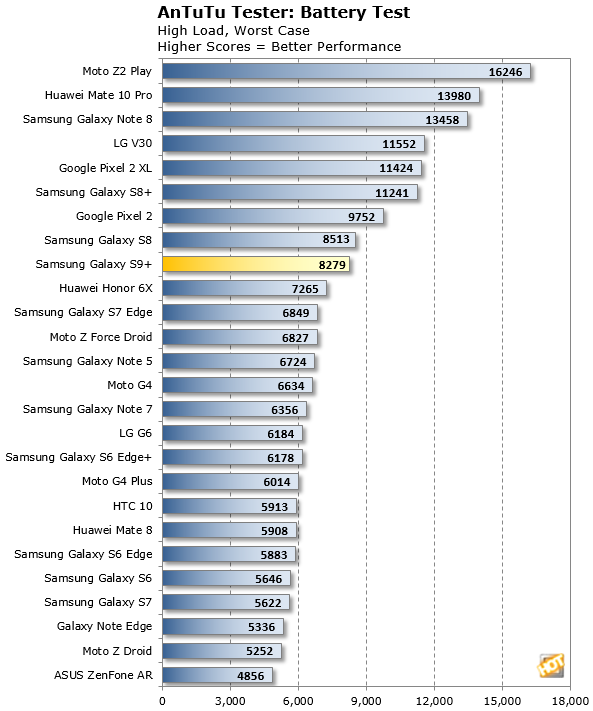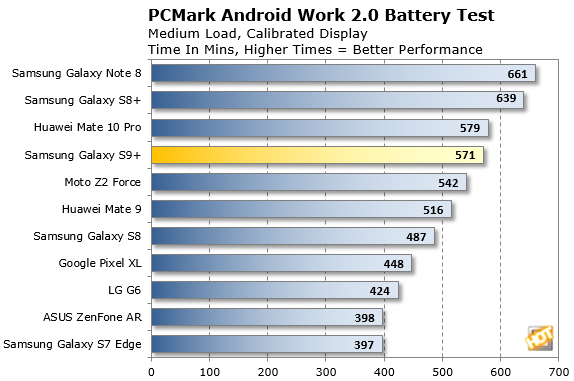Samsung Galaxy S9+ Review: Fantastic And Fast With A Killer Camera
To determine how the Samsung S9+ handles with respect to battery life, we've commissioned two very different test utilities. AnTuTu's Battery test is a worst case, high workload benchmark utility that stresses the CPU, GPU, system memory and even maximizes display brightness in order to push phones to their always-on limits. Generally speaking, in real world scenarios the average mainstream user would not likely utilize use a phone this way, certainly not all day long until its battery gave up the ghost. However, it's a relative gauge for comparable high load performance. Then we have PCMark for Android's Work 2.0 battery test, which demands both a lighter duty work load, and is setup to run on calibrated, moderately lit display brightness settings. The playing field is more level in the PCMark test since variation is display brightness is minimized with pre-test calibration.
|

Futuremark's PCMark for Android Work 2.0 Battery test takes workloads from the benchmark itself (image and video editing, email and web browsing) and scripts them in a loop that runs until battery levels drop below 20 percent. This test is much more real-world in terms of its setup, because we calibrate display brightness on all devices to 200 Lux and the test then locks that display brightness in for the duration. As a result, with only WiFi and cell radios on (Bluetooth and NFC were off, with DND mode turned on), we're able to see how long a device will last, timed to the minute as it runs down from 100 percent to 20 percent remaining battery life.


Samsung Galaxy S9+ At $839 -- Galaxy S9 At $719 - Find Them On Amazon

 One final attribute for the Galaxy S9+ that we need to weigh in is cost. Fortunately, we're already seeing both the S9+ and the S9 listed on Amazon with a March 16th availability date. The Galaxy S9+ retails for $839 unlocked while an S9 weighs in at $719. Carrier pricing may vary with differing subsidies or payment plans if purchased under contract, though Samsung did also confirm these unlocked prices. This places the Galaxy S9+ and S9 roughly on par with the Galaxy S8+ and S8 when they launched last year, and right in the meat of premium flagship Android phone pricing currently. In other words, these new Galaxies are still pricey, but also competitive with similar class, current generation phones like Google's Pixel 2 XL or the LG V30, which can be had for a few bucks less. Is this pricing justified? Again, relatively speaking with respect to the current landscape of premium Android phones, and certainly compared to a much pricier iPhone X, we think it is; not that we're fan's of the current trend of premium smartphone pricing, mind you.
One final attribute for the Galaxy S9+ that we need to weigh in is cost. Fortunately, we're already seeing both the S9+ and the S9 listed on Amazon with a March 16th availability date. The Galaxy S9+ retails for $839 unlocked while an S9 weighs in at $719. Carrier pricing may vary with differing subsidies or payment plans if purchased under contract, though Samsung did also confirm these unlocked prices. This places the Galaxy S9+ and S9 roughly on par with the Galaxy S8+ and S8 when they launched last year, and right in the meat of premium flagship Android phone pricing currently. In other words, these new Galaxies are still pricey, but also competitive with similar class, current generation phones like Google's Pixel 2 XL or the LG V30, which can be had for a few bucks less. Is this pricing justified? Again, relatively speaking with respect to the current landscape of premium Android phones, and certainly compared to a much pricier iPhone X, we think it is; not that we're fan's of the current trend of premium smartphone pricing, mind you.Ultimately, when you boil it all down, though it's still a pricey option, the new Samsung Galaxy S9+ is simply one of the best Android phones money can buy right now. It's arguably one of the best designed large format Android phones too, with gorgeous, sleek styling. And though battery life so far (we're still re-testing) hasn't dropped in quite where we expected, it's still pretty solid there too. The Galaxy S9+ is also currently the fastest Android handset on the market, with the best camera we've ever tested, as well as easily the best display of any smartphone we've seen to date. This new Galaxy S device also brings some innovative new features to the mix as well, like Super Slow-Mo, which is just plain fun. Regardless, that's a lot of "bests" Samsung has going on here and that, in our opinion adds up to an Editor's Choice device. Samsung nailed it with the new Samsung Galaxy S9+. Fantastic phone.

|
|






